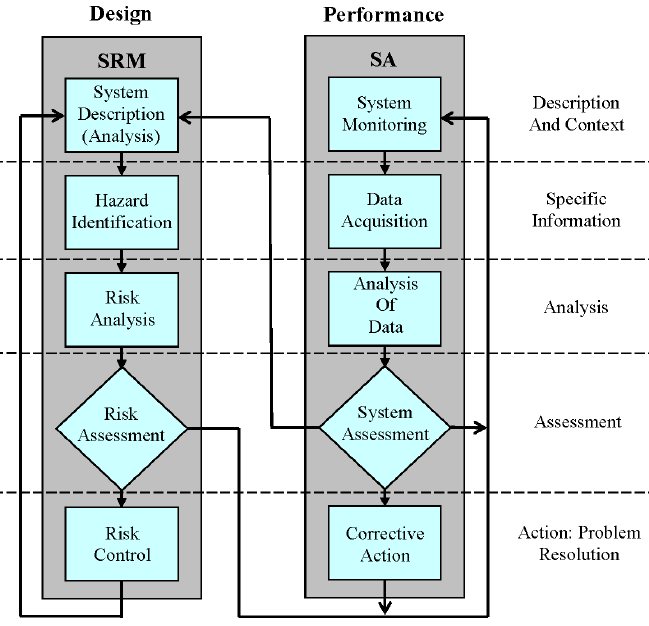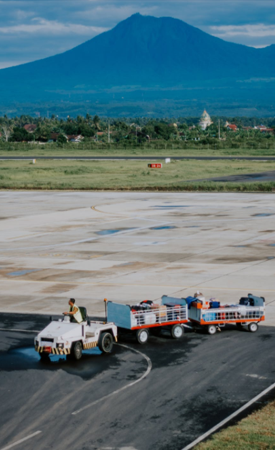Do You Understand Aviation SMS Solutions' Architecture?

After a dozen years being an aviation safety management systems (SMS) database architect, I have heard just about every question imaginable about aviation safety software.
Among the most common questions we get are:
- What is a division in your aviation SMS database; and
- How many divisions do I need?
Before we answer this question, we should familiarize you with the overall architecture of an aviation SMS database solution.
Related Aviation SMS Database Articles
- 5 Most Important Things to Know Before Buying Aviation SMS Database
- 7 Signs You Need an Aviation Safety Management (SMS) Database
- Understanding Complex Aviation SMS Database Configurations - Portals
Modern aviation SMS database solutions are designed to reduce the grief associated with paper and MS Excel spreadsheets. Instead of being a dumb table, like a sheet within a spreadsheet, an SMS database has business logic associated with the programming code. This allows email and text notifications to be sent at certain points, or other business logic to process and display SMS data to enhance decision-making processes.
Many aviation safety managers begin their SMS implementations using spreadsheets and email to pass messages and store SMS data. This data management strategy is not efficient and considerable time is required to comply with all the SMS documentation requirements. Furthermore, annual report generation using spreadsheets requires considerable effort that most safety managers don't eagerly anticipate each year.
Some safety managers may adopt point solutions and emails, such as a converted "Help Desk" ticket system to serve as their safety reporting system and risk management system.
These home-grown solutions end up costing aviation service providers more money in lost time than if they simply found a commercial-off-the-shelf SMS solution. Low-cost, commercial software was designed to address SMS regulatory requirements. These commercial SMS databases are being used by hundreds of aviation service providers. This high volume of users allows the implementation of industry-accepted workflows. Furthermore, costs are lower than if the company had to develop the solution in-house.
When an aviation service provider selects a commercial SMS database provider, he will be with that company for at least a decade. You should be assured that the SMS database has all the necessary tools that will facilitate regulatory compliance, as well as add financial value to your organization. SMS performance monitoring dashboards should be a priority as they allow upper management to easily monitor SMS performance and quickly respond to substandard safety performance.
The best aviation SMS database solutions are scalable for small, medium, and large aviation service providers. SMS Pro has the ability for administrators to turn off features that are not aligned with the complexity of their operations. Besides having the ability to turn features on and off, and customize your classification schemes, SMS Pro also supports a feature called "divisions." Divisions are a very important topic, especially when your organization is searching for efficiencies.
Divisions allow the addition of additional business units to adopt the same risk management workflows as the aviation SMS. Since the safety risk management (SRM) and safety assurance (SA) methodology is so sound, why restrict its use for only safety? You can easily extend SMS Pro to be used by other business units, such as:
Quality assurance department (auditing suite);
- Environmental;
- HR;
- HSE, OSHA or OHSA;
- Administration; or
- Commercial and marketing.
Let's dig in further.
Related Aviation SMS Software Articles
- How to Choose Aviation SMS Software - Educating SMS Professionals
- How to Comply With Regulation (EU) 376/2014 - Aviation ECCAIRS Reporting Compliance Software
- How Does Aviation Safety Software Improve Safety? - Aviation SMS
The Basics of Modern Aviation SMS Solutions

If your aviation SMS database solution is not Web-based, you are missing out on many opportunities. You will never have a best-in-breed aviation SMS. Period! Having Web-enabled SMS database software multiplies the effectiveness of your safety team by approximately three; however, if you focus on all the elements of an ICAO-compliant SMS, the factor will increase from five to ten, depending on the complexity of your operations.
Discussing the benefits of a Web-based SMS program is beyond the scope of this article, so suffice it to say, every modern aviation SMS solution should be Web-based. The paper will never cut it. MS Excel and Word will cost you too much time and money in both:
- Lost productivity; and
- Lost services that could otherwise be offered to your stakeholders; and
- Inability to efficiently monitor SMS performance.
Web-based portals offer secure aviation SMS data accessible to all company stakeholders based on their provided security permissions. The best solutions maximize the utility of templated email notifications and SMS text messaging.
An aviation SMS database must manage the documentation requirements of all four pillars:
- Safety Policy;
- Safety Risk Management (SRM);
- Safety Assurance (SA); and
- Safety Promotion.
Safety Policy and Safety Promotion could possibly be managed by:
- SharePoint;
- spreadsheets; and
- email.
However, SRM and SA processes require significantly more data management capabilities. The ability to document and track many SMS documentation requirements from SRM and SA include:
- Hazards;
- Risks;
- Risk controls;
- Investigations;
- Corrective actions and preventive actions;
- Audits; and
- Trending analysis.
Related Articles on Aviation SMS Trend Analysis
- How to Prepare Data for Trend Analysis in Risk Management Programs
- How to Use Trending Charts in Aviation SMS
- Six Steps How to Perform Trend Analysis in Aviation SMS

From the image above, your safety reporting and auditing systems are feeding the "Data Acquisition" box under SA.
Hazards, risks, and risk controls are managed, documented, and reviewed on the SRM side.
In immature SMS implementations, SRM data is managed in spreadsheets. These spreadsheets are affectionately called a "Hazard Register" or Hazard Risk Register.
Spreadsheet hazard registers are available from multiple places on the Web, but often SMS consultants will provide these "Trojan Horses" as they are providing SMS training or SMS implementation consulting. All identified hazards, risks, and risk controls are cataloged and risk assessed in these spreadsheets.
The reason I call these spreadsheets "Trojan Horses" is because they come into the organization as something that appears very useful initially, but as the Hazard Register grows, it becomes more difficult to manage and monitor. This becomes a big challenge for aviation service providers with 200 to 500 employees in their fourth to the eighth year of their SMS implementation.
Alternatively, your SRM data may reside in a disconnected point solution without a direct data connection to the SA side. As "System Monitoring" activities send in "issues" into the SMS risk management workflow, safety managers often have to review hazards, risks, and risk controls in their spreadsheets. This is a common problem and does not allow for effective monitoring of risk controls.
As one can logically see, the best solution is to have a single SMS database that seamlessly integrates SRM and SA risk management processes. The single SMS database solution allows for easy and efficient setting and monitoring of key safety performance indicators or KPIs. And who doesn't like to have an easy way to track and monitor SMS performance using KPIs?
Related Aviation SMS KPI Monitoring Articles
- How to Set and Monitor Key Performance Indicators (KPIs) in Existing SMS
- How to Automatically Monitor KPIs in Aviation SMS
- How to Best Monitor KPIs in Your Aviation SMS
SMS Database Manages All Four Pillars

As a further bonus, a full-featured SMS database has the ability to manage the other two pillars' SMS documentation requirements, namely Safety Policy and Safety Promotion. This becomes very important when you consider that SRM and SA processes are dependent on a healthy safety reporting culture.
Healthy safety culture is cultivated using Safety Promotion activities, such as:
- Newsletters;
- Surveys;
- Safety Meetings;
- Lessons learned library;
- Safety messages; and
- SMS training.
Finally, Safety Policy SMS documentation requirements may as well be handled in the SMS database. The SMS database will be able to display your organization's:
- Safety Policies and Procedures;
- Safety Accountabilities and Responsibilities to the SMS;
- Emergency Response Plans; and
- Goals and Objectives.
Goals and objectives are tied to your KPIs. In fact, each one of your goals and objectives should be tied to at least one KPI. You may be used to calling KPIs safety performance indicators or SPIs. SPIs are subsets of KPIs but with a focus on safety. For our discussion, KPI is the same as SPI.
KPI = SPI
So what we have now is a database that has SRM and SA workflows that can track KPIs. KPIs can be monitored using the SMS database's goals and objectives tracking features. This is a great labor and time-saving capability.
Imagine setting annual safety goals and objectives and having to track them all manually. By having a single SMS database that manages SMS documentation from all four pillars, the aviation service provider has a solution that will withstand the most stringent auditor's scrutiny. If you have not yet noticed, SMS auditors like to focus on safety goals and objectives.
Safety goals and objectives can be related to the "canary in the coal mine." When there is a problem setting and tracking safety goals and objectives, auditors recognize that this SMS implementation may also have challenges setting and tracking KPIs.
As we mentioned previously, safety goals and objectives are tied to KPIs.
KPIs are directly linked to both SRM and SA activities.
Safety Promotion activities influence SA activities.
SMS is a system. SMS data management strategies must also look at SMS as a tightly knit system that requires all SMS data to be easily accessible to be monitored effectively. Otherwise, accountable executives will be unable to fulfill their responsibility to regularly review SMS performance and be able to identify and quickly address any substandard safety performance.
A well-designed SMS database software suite ties all SMS documentation elements together under one unified platform.
Related Aviation SMS Database Articles
- 3 Benefits of Aviation Safety Management System (SMS) Databases
- How European Operators Know They Need Aviation Safety Management Systems (SMS) Database
- Tips Writing SMS Manuals With Aviation Safety Database Solutions
Aviation Safety Portal Is the Main Wrapper

The aviation safety portal is accessible by typing a URL into the address bar. A user belongs to one or more portals and will require a username and password to access the portal.
Yes, a user can belong to more than one safety portal.
What is the business case for having users participate in multiple safety portals for the same company? Imagine your parent company has four aviation companies. Otherwise, if you belong to an airport authority, imagine that your airport authority manages eight airports. Each airport or aviation company can have its own portal.
Best practices will have one operating certificate for each portal. This becomes practical when you consider selling an asset, which is common. You will want a clean break when you sell one of your companies, as the SMS data should go with the sold property.
A user, such as a safety manager or director of safety, who works between each of the above business units can have an account in each entity's portal. Instead of having to remember a username and password for each portal, the same credentials can work across all portals.
The advantages are surprisingly obvious:
- Reduced training costs;
- Reduced company SMS software costs;
- Increased employee productivity; and
- The coherent system that can aggregates real-time reports across all companies.
Do you follow me so far?
Aviation SMS Solutions Consist of Modules Inside a Safety Portal
Almost every modern aviation safety solution consists of an SMS portal accessed by a username and password over the Web. Once inside the safety portal, users see common modules that satisfy business requirements, such as:
- Safety reporting system;
- Risk management system;
- Tracking corrective/preventive actions;
- Training and qualifications system;
- Documentation management; and
- Auditing system.
With a safety portal approach, all users enter and modify common safety data within their sphere of control and their assigned permissions.
Imagine safety data in one big bucket accessible by all users in the system. Not all employees will enjoy the same access. Permissions are role-based and managed by your SMS admin. Rarely do aviation service providers allow all employees to see all SMS data, except in highly transparent safety cultures. Based on over a dozen years of empirical evidence, only two to three percent of companies have this level of transparency. And never will this company have union employees or be part of the FAA's ASAP program. ASAP programs actually hurt transparency in aviation SMS.
In an aviation SMS database, common roles include:
- SMS Administrator;
- Safety Manager(s);
- Department Heads (in charge of approving and managing corrective/preventive actions);
- Internal and External Auditors;
- Data entry personnel; and
- Basic line employees.
Now that you have a good idea of portals, there are a couple of informal rules we use to determine whether you need to add another portal.
- Does your company have multiple business entities?
- Do the business entities have different:
- Operating certificates;
- Accountable executives;
- Policies and procedures;
- SMS documentation; and
- Duties and responsibilities of key safety personnel?
When associated business entities don't share the above, it is recommended that each business entity has its own portal. A single SMS database should not be used by two companies as a general rule. The concern from the regulator will be whether there is direct control over SMS data management activities by each accountable executive.
There are a few companies that provide SMS data management services for small aviation service providers. This is beyond the scope of our discussion.
Related Aviation SMS Transparency Articles
- Why Transparency Promotes Safety Culture in Aviation SMS
- Transparency and Aviation Safety Data Security - User Roles SetUp
- Overcoming Resistance to Change Through Transparency in Aviation SMS
Divisions Create Silos in Your Aviation Safety Data
With a default SMS portal, there is no grouping of users into departments or sections. All users see the same data as long as they maintain the proper permissions.
In many cases, this solution works fine for smaller companies with fewer than 80-100 employees. Smaller companies typically have informal, flatter organizational structures where department heads from one department commonly share authority in other departments.
Whenever simple or loosely structured aviation service providers ask whether they need to separate their data based on functional units, we ask questions about their corporate culture. Questions may uncover:
- Do you have operations in multiple regions?
- Do managers at one location (or department) direct employees at another location (or department)?
- Do you want managers in Flight Ops to see reported issues from Engineering?
- How many reported issues do you receive from each department?
- Do you want xyz department's data isolated from other departments, such as security data?
When aviation service providers wish to keep data separate from other users with similar roles and permissions, then divisions are used. It is important to note that you understand that we refer to "Users with the same permissions." For example, let's consider an airport authority. You may have a separate safety manager for each airport. You may not want all safety managers to see reported issues at all airports. Likewise, you may not want maintenance personnel to see SMS data related to flight ops and vice versa. Again, this is where your comfort level is with the transparency of SMS data.
Related Aviation SMS Transparency Articles
- How to Practice Safety Transparency and Just Culture in SMS
- A Key to Transparency in Aviation SMS
- Privacy, Transparency, and Confidentiality in Aviation Safety Management
Divisions Allow Separation of SMS Data
Divisions allow the separation of data and users into logical groups.

Examples include:
Functional
- Ground handling;
- Engineering;
- Flight ops; and
- Quality
Or
Geographic
- Europe;
- Middle East;
- North America;
- Airport A;
- Airport B; or
- Airport C
Divisions Add Considerable Power & Flexibility
Adding divisions is not a trivial exercise, as each division has its own:
- Configurable risk matrix;
- Classification schemes;
- Key performance indicators (KPIs);
- Ability to create meetings with only users in a single division; and
- Audit schedules.
If you don't seriously need a division, we don't recommend that you add them without careful consideration, as undoing a division will require a lot of work. You will need to:
- Reclassify users and put them into another division;
- Reclassify all reported safety issues in the division; and
- Re-assess all reported safety issues using the new division's risk matrix.
Divisions can be added at any time. For example, when you first start your SMS implementation, you may only envision using the risk management processes to manage safety and compliance concerns. As the SMS matures, management will realize that the risk management workflows make very good sense and should be applied to other operational areas, such as:
- Administration;
- Environmental;
- Safety department; or
- HSE.
An SMS database has considerable flexibility. Well, I should rephrase this: some SMS databases have considerable flexibility. You have to be careful when selecting SMS software, as this choice can be expensive to change in the future.
Related Aviation SMS Software Articles
- 20 Benefits of Aviation SMS Software
- Spreadsheets vs Software for Aviation Safety Management
- How to Choose the Best Aviation Safety Database Software
Not All SMS Databases Are Single Databases but Multiple Databases
Some companies aggregate software solutions to create a different type of hybrid SMS solution. For example, ETQ does a good job of pulling together point solutions and putting them together under a separate brand. Based on this approach, it is highly unlikely that ETQ has a single integrated database, but multiple databases cobbled together for their SMS database offering.
There are pros and cons to this approach of cobbling together point solutions. The biggest drawbacks are:
- Lack of flexibility (customization); and
- Slower support times.
Slower support times are understandable with a hybrid point solution. When the safety manager has a support problem or query, he contacts the SMS database provider. The SMS database provider then contacts the original developers who may be providing the technical support. Once the original developers fix the problem, the developers contact the SMS database provider who then relay the support response finally to the safety manager.
Final Thoughts on SMS Database Solutions' Architecture
Now that you have a good idea of portals and divisions, there are couple rules of thumb we use to determine whether you need to add divisions.
Does your company have more than 80-100 employees?
If you have sister companies using the same portal, do they all use the same:
- Accountable executive;
- Policies and procedures;
- SMS documentation; and
- Duties and responsibilities of key safety personnel?
If you ever have questions, you can always ask us for advice. We've been doing this for over a dozen years and have worked with hundreds of:
- Airlines;
- Airports;
- MROs (or AMOs);
- FBOs;
- Flight schools; and
- Civil aviation authorities.
Although we have worked with many operators, we understand each company is unique. Working together, we can find an excellent solution for your safety program.
Remember: we are here to help.
If you have not yet watched the SMS Pro demo videos, here they are for your review.
Last updated January 2025.






